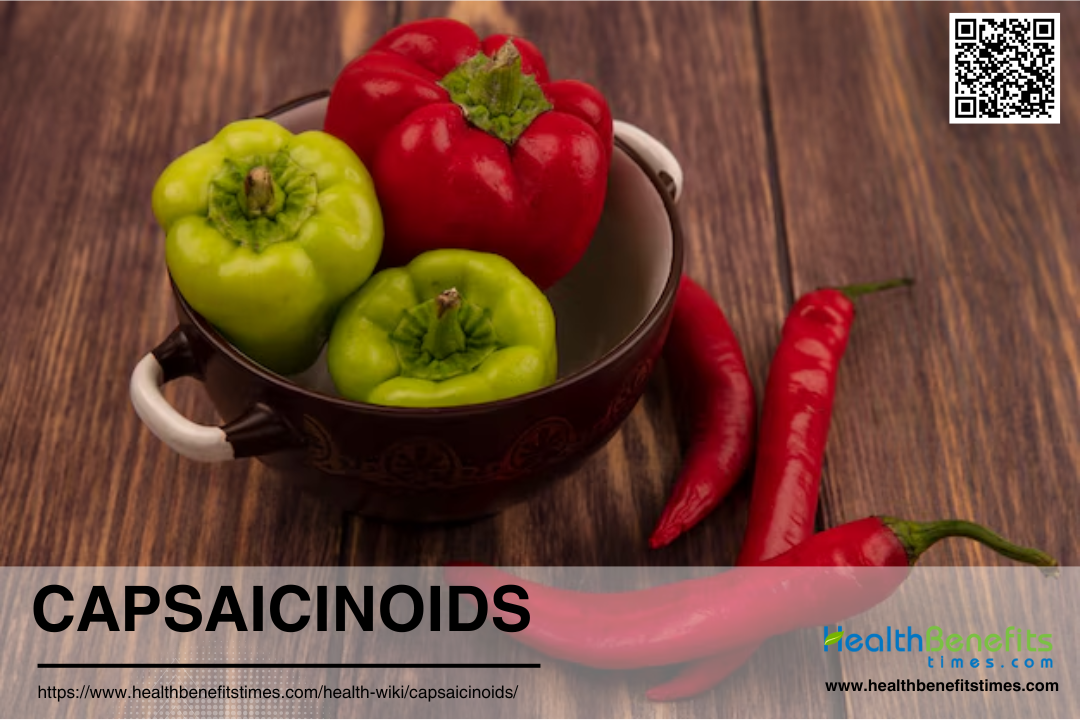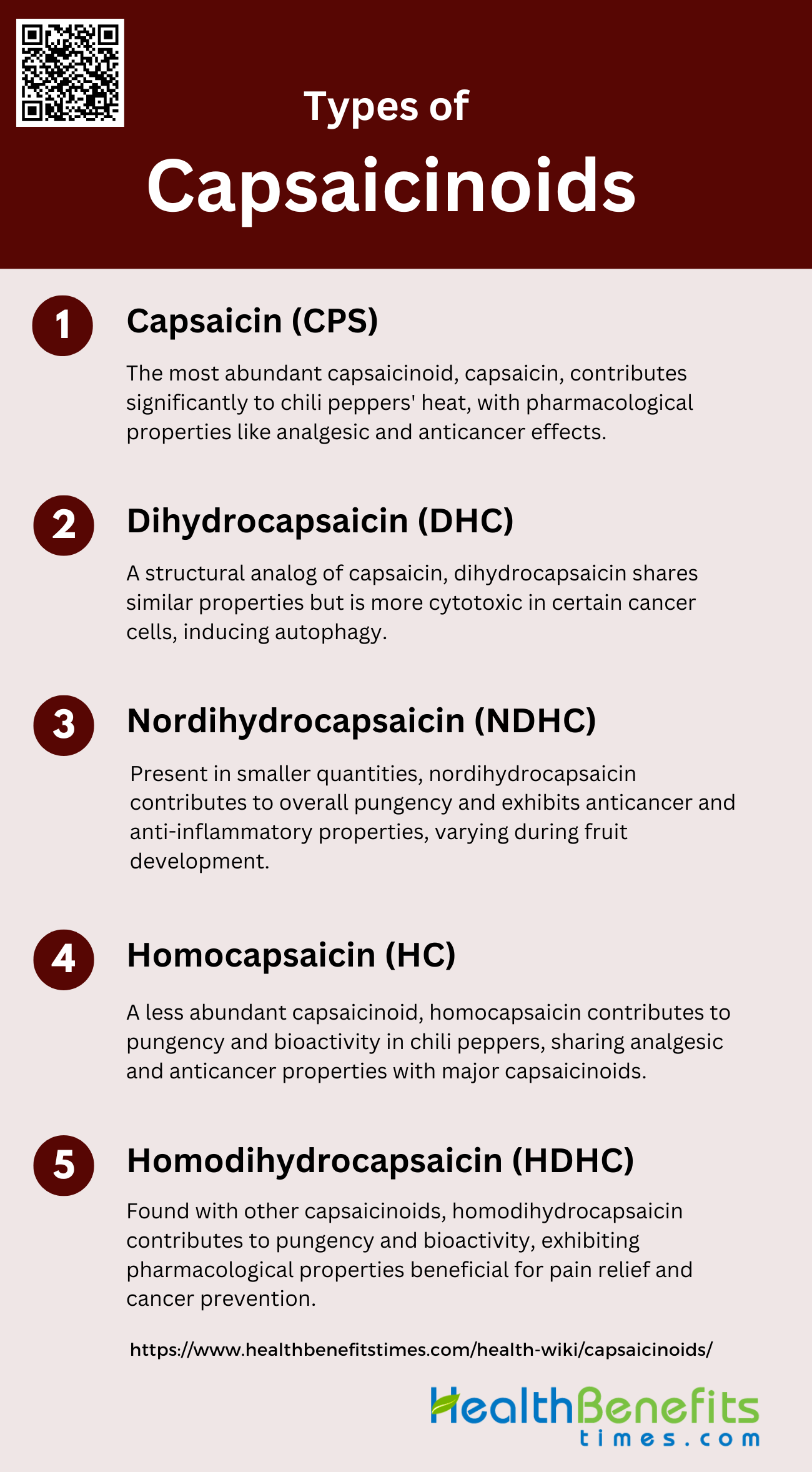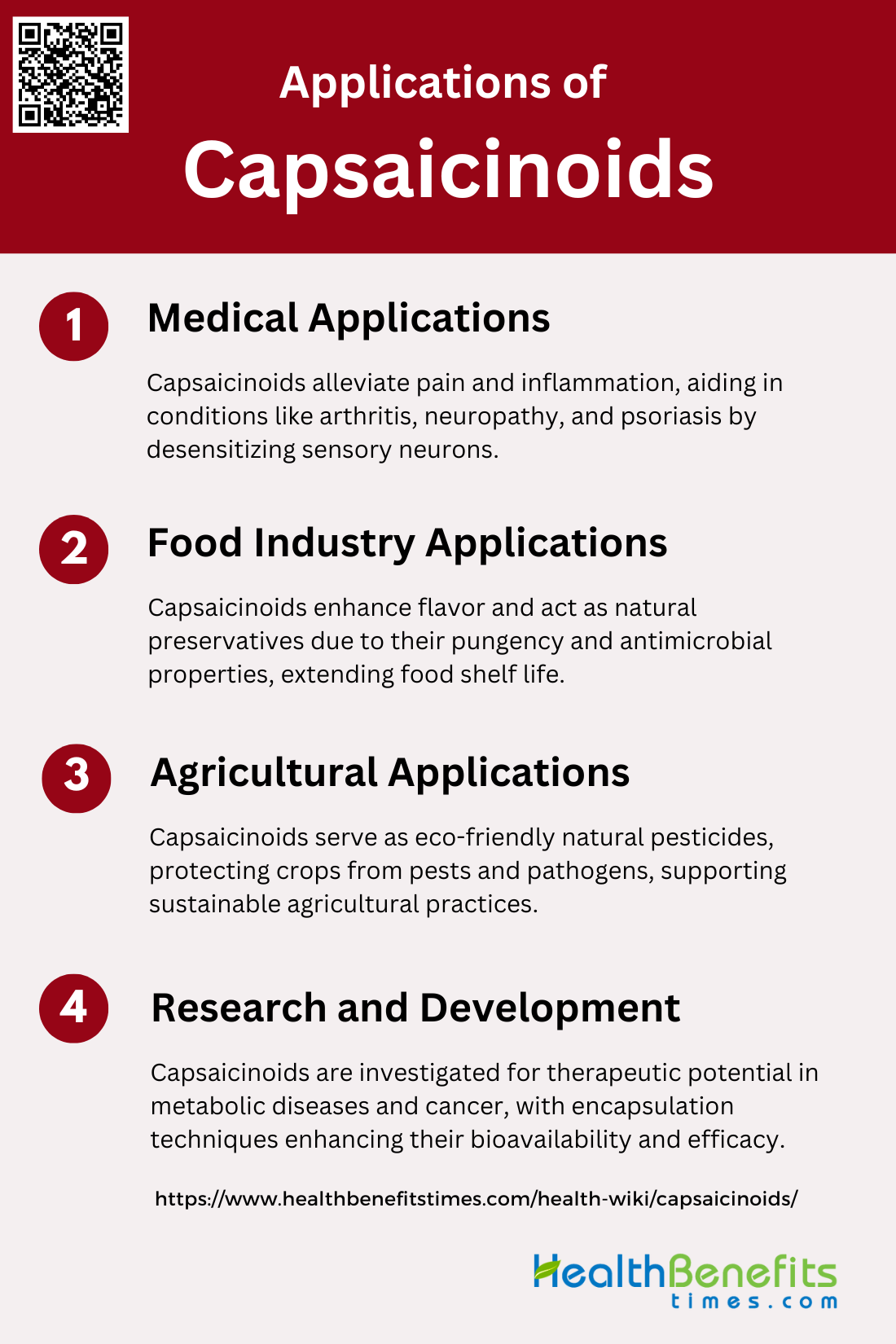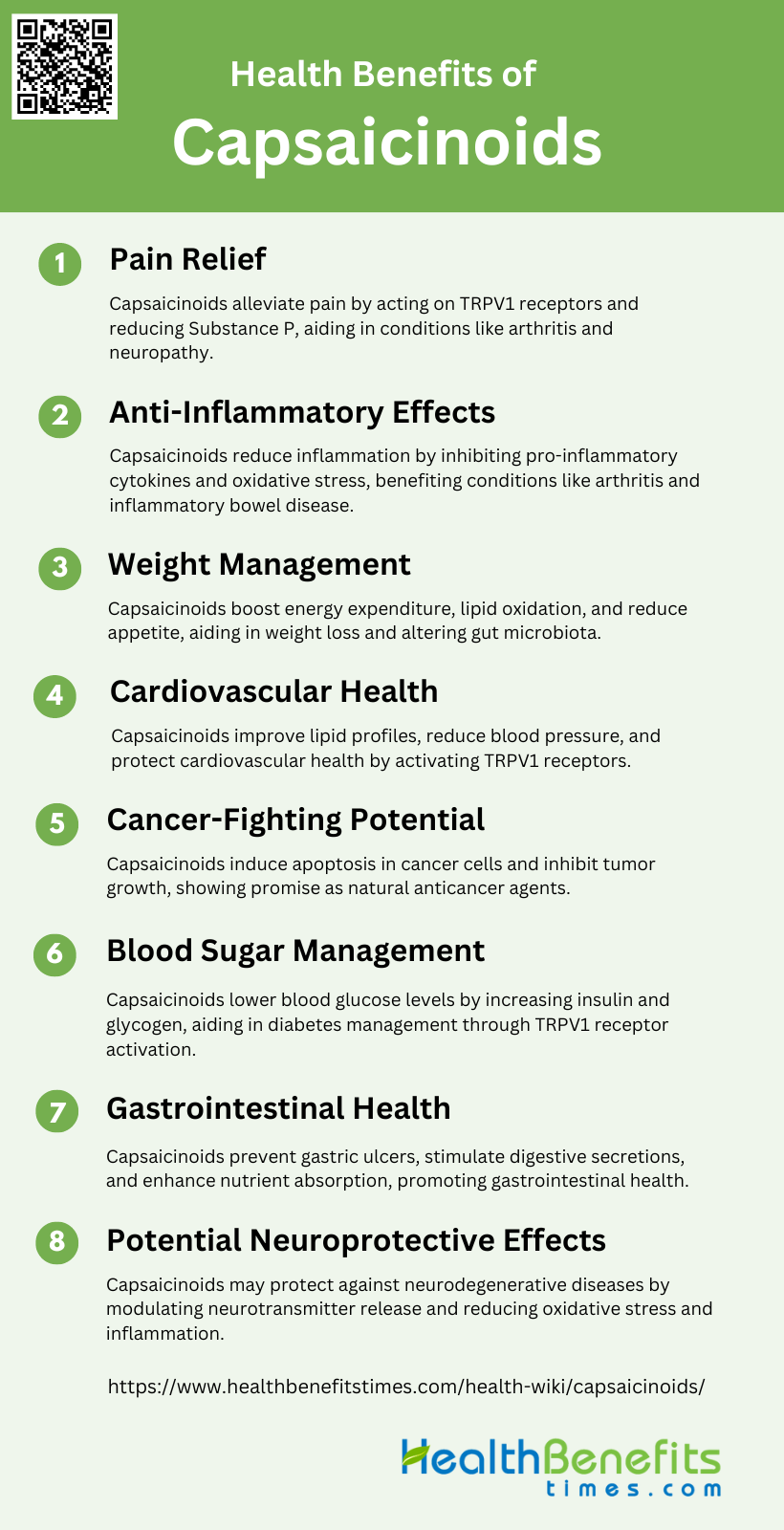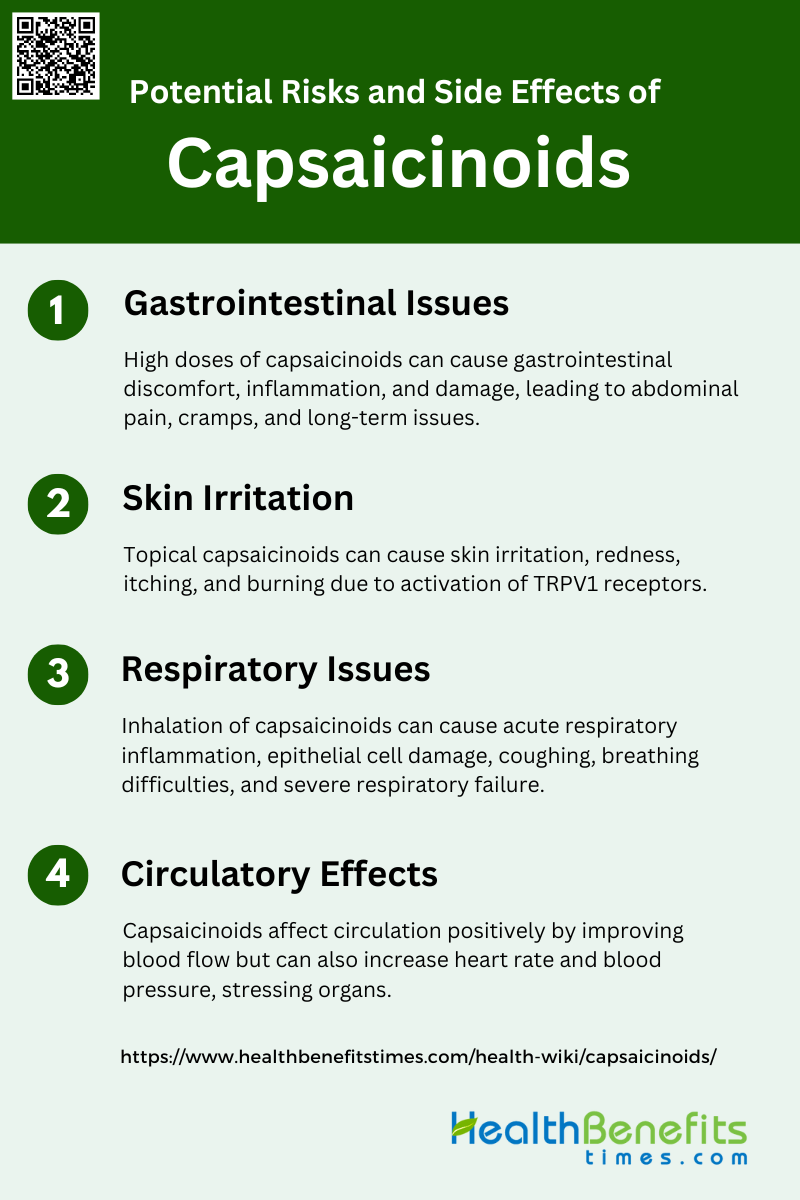Capsaicinoids are a group of compounds responsible for the characteristic pungency and heat sensation in chili peppers (Capsicum spp.). These bioactive compounds are produced exclusively by plants in the Capsicum genus and are primarily found in the fruit’s interlocular septum and, in some extremely pungent varieties, on the inside surface of the pericarp. The most abundant and well-known capsaicinoid is capsaicin, which is the major active compound responsible for the spicy taste of chili peppers. Capsaicinoids have garnered significant scientific interest due to their potential health benefits, including antioxidant, antimicrobial, and anticancer properties, as well as their role in weight management and pain relief. The concentration of capsaicinoids in peppers can vary widely depending on factors such as the specific cultivar, growing conditions, and fruit maturity, with some extremely pungent varieties like ‘Bhut Jolokia’ containing particularly high levels.
Types of capsaicinoids
Capsaicinoids are a diverse group of compounds found in chili peppers that contribute to their characteristic heat and pungency. These compounds vary in their chemical structure and potency, resulting in different levels of spiciness and potential health benefits. Below are the main types of capsaicinoids:
1. Capsaicin (CPS)
Capsaicin (CPS) is the most abundant and well-studied capsaicinoid found in chili peppers. It is primarily responsible for the pungency and heat sensation associated with these fruits. Studies have shown that capsaicin content can vary significantly depending on the pepper variety and its stage of ripening. For instance, in the Cayenne pepper (Capsicum annuum L.), capsaicin represents a substantial portion of the total capsaicinoid content, ranging from 79% to 90% during different ripening stages. Additionally, in Capsicum chinense varieties like ‘Habanero Roxo,’ capsaicin accounts for more than 80% of the total capsaicinoids. Capsaicin has been extensively researched for its pharmacological properties, including analgesic, anticancer, and anti-inflammatory effects.
2. Dihydrocapsaicin (DHC)
Dihydrocapsaicin (DHC) is a saturated structural analog of capsaicin and is the second most abundant capsaicinoid in many chili pepper varieties. It shares similar pungency and pharmacological properties with capsaicin but has been found to be more cytotoxic in certain cancer cell lines. DHC induces autophagy in human cancer cells in a catalase-regulated manner, which may contribute to its cytotoxic effects. In various studies, DHC has been shown to constitute a significant portion of the total capsaicinoid content, such as in the Cayenne pepper, where it, along with capsaicin, makes up the majority of the capsaicinoid profile. The relative distribution of DHC can vary widely among different chili cultivars, ranging from 31% to 71% of the total capsaicinoid content.
3. Nordihydrocapsaicin (NDHC)
Nordihydrocapsaicin (NDHC) is another important capsaicinoid found in chili peppers, though it is generally present in smaller quantities compared to capsaicin and dihydrocapsaicin. Nordihydrocapsaicin has been identified in various pepper cultivars, including those grown in temperate climates like Denmark. In the Malagueta pepper (Capsicum frutescens), NDHC shows a distinct pattern of accumulation during fruit ripening, similar to other dihydrocapsaicin-like capsaicinoids. The content of NDHC, along with other capsaicinoids, increases significantly during the early stages of fruit development and then stabilizes or decreases slightly as the fruit matures. NDHC contributes to the overall pungency and pharmacological properties of chili peppers, including potential anticancer and anti-inflammatory effects.
4. Homocapsaicin (HC)
Homocapsaicin (HC) is one of the less abundant capsaicinoids but still plays a role in the overall pungency and bioactivity of chili peppers. It has been detected in various pepper cultivars, including those grown in different climatic conditions. In studies involving the Cayenne pepper, homocapsaicin was found to be present along with other major capsaicinoids, contributing to the total capsaicinoid content. The extraction and quantification of homocapsaicin, along with other capsaicinoids, have been optimized using methods like ultrasound-assisted extraction and high-performance liquid chromatography. Although less studied than capsaicin and dihydrocapsaicin, homocapsaicin shares similar pharmacological properties, including potential analgesic and anticancer effects.
5. Homodihydrocapsaicin (HDHC)
Homodihydrocapsaicin (HDHC) is another minor capsaicinoid found in chili peppers, often in conjunction with other capsaicinoids like capsaicin and dihydrocapsaicin. It has been identified in various studies focusing on the capsaicinoid content of different pepper varieties, such as the Naga Jolokia and Malagueta peppers. HDHC, along with other dihydrocapsaicin-like capsaicinoids, shows a similar pattern of accumulation during fruit ripening, contributing to the overall pungency and bioactivity of the peppers. The extraction and analysis of HDHC have been facilitated by advanced chromatographic techniques, ensuring accurate quantification and understanding of its role in the capsaicinoid profile. Like other capsaicinoids, HDHC exhibits pharmacological properties that may be beneficial for pain relief, cancer prevention, and other therapeutic applications.
How Capsaicinoids Work
Capsaicinoids exert their effects by interacting with the transient receptor potential vanilloid 1 (TRPV1) receptor, which is predominantly expressed by sensory neurons. This interaction triggers a cascade of physiological responses, including the sensation of heat and pain. Below are the primary mechanisms through which capsaicinoids work:
1. Interaction with Sensory Neurons
Capsaicinoids, such as capsaicin, interact with sensory neurons primarily through the transient receptor potential vanilloid 1 (TRPV1) receptor. TRPV1 is a nonselective cation channel predominantly expressed by sensory neurons, which plays a key role in detecting noxious stimuli like capsaicin, heat, and acidic conditions. When capsaicin binds to TRPV1, it causes an influx of calcium ions (Ca2+), leading to the excitation of nociceptive neurons and the sensation of pain. This interaction can also result in the desensitization of TRPV1, reducing the neuron’s responsiveness to subsequent stimuli, which is a mechanism utilized in pain relief therapies.
2. The Role in Heat Sensation
Capsaicinoids are well-known for their role in heat sensation, which is mediated through the activation of TRPV1 receptors. TRPV1 can be activated by capsaicin, heat, and protons, making it a polymodal receptor. When activated by capsaicin, TRPV1 channels open, allowing Ca2+ and sodium ions (Na+) to enter the cell, which generates an action potential that is perceived as a burning sensation. This mechanism is similar to how the body senses actual heat, as TRPV1 is also activated by temperatures above 43°C. The activation of TRPV1 by capsaicin mimics the sensation of heat, which is why capsaicin is often described as “hot”.
3. Impact on Metabolism
Capsaicinoids have a significant impact on metabolism, primarily through their interaction with TRPV1 receptors. Activation of TRPV1 by capsaicin has been shown to increase energy expenditure and fat oxidation, contributing to its anti-obesity effects. Capsaicin can modulate the function of various ion channels and enzymes involved in cellular excitability and metabolism, beyond its interaction with TRPV1. Additionally, capsaicin-induced activation of TRPV1 can lead to the release of neuropeptides like calcitonin gene-related peptide (CGRP), which can influence metabolic processes. These metabolic effects make capsaicinoids a subject of interest for weight management and metabolic health research.
Sources of Capsaicinoids
Capsaicinoids, the active compounds responsible for the heat in chili peppers, are primarily found in various species of the Capsicum genus. These compounds not only contribute to the pungency of peppers but also have significant applications in medicine and food industries. Understanding the common sources and concentration levels of capsaicinoids in different peppers is essential for their effective utilization.
1. Common Peppers Containing Capsaicinoids
Capsaicinoids are primarily found in various species of the Capsicum genus, which includes a wide range of peppers. Common peppers known for their capsaicinoid content include Jalapeño, Habanero, and Bhut Jolokia. Jalapeños are widely recognized for their moderate heat and are frequently used in culinary dishes. Habaneros, on the other hand, are known for their intense heat and fruity flavor, making them popular in hot sauces and spicy foods. Bhut Jolokia, also known as Ghost Pepper, is one of the hottest peppers in the world and is often used in extreme spicy food challenges. Other notable varieties include Capsicum annuum cultivars such as Serrano, Puya, Ancho, and Guajillo, which are also rich in capsaicinoids and used in various culinary applications.
2. Concentration Levels in Different Peppers
The concentration of capsaicinoids varies significantly among different pepper varieties and even within the same variety depending on factors such as ripening stage and environmental conditions. For instance, Habanero peppers can have capsaicinoid concentrations ranging from 1.33 mg/g to 3.86 mg/g fresh weight, with capsaicin making up more than 80% of the total capsaicinoids. In Capsicum annuum cultivars, capsaicin levels can range from 0 to 4820 µg/g depending on the ripening stage, with dihydrocapsaicin levels also varying significantly. Bhut Jolokia peppers exhibit a skewed distribution of capsaicinoid content, indicating high variability within the population. Additionally, environmental factors such as temperature can influence capsaicinoid levels, with some varieties showing increased concentrations under higher temperatures. The pericarp and placenta of peppers also show different capsaicinoid concentrations, with the placenta generally having higher levels.
Applications of Capsaicinoids
Capsaicinoids, the active compounds in chili peppers, have a wide range of applications across various fields due to their unique properties. From medical treatments to food industry uses, agricultural benefits, and ongoing research, these compounds offer significant advantages. Here is an overview of their diverse applications:
1. Medical Applications
Capsaicinoids, primarily found in chili peppers, have significant medical applications. They are known for their analgesic properties, making them effective in pain management for conditions such as arthritis and neuropathy. Additionally, capsaicinoids exhibit anti-inflammatory effects, which can help reduce inflammation in various medical conditions. They are also used in treating skin disorders due to their ability to desensitize sensory neurons, providing relief from conditions like psoriasis.
- Pain Management: Capsaicinoids are effective in treating pain associated with arthritis, cystitis, and neuropathy by desensitizing sensory neurons.
- Inflammation Reduction: These compounds exhibit anti-inflammatory properties, beneficial in reducing inflammation in various conditions.
- Skin Disorders: Capsaicinoids help in treating skin conditions like psoriasis by desensitizing sensory neurons.
2. Food Industry Applications
In the food industry, capsaicinoids are widely used for their flavoring and preservative properties. They add a distinctive pungency to foods, enhancing flavor profiles in various cuisines. Additionally, capsaicinoids possess antimicrobial properties, making them effective natural preservatives that can extend the shelf life of food products.
- Flavoring: Capsaicinoids are used to add pungency and enhance the flavor profiles of various dishes.
- Preservative: Their antimicrobial properties make capsaicinoids effective natural preservatives, extending the shelf life of food products.
3. Agricultural Applications
Capsaicinoids have promising applications in agriculture, particularly in pest control. They act as natural pesticides, protecting crops from various pests and pathogens without the harmful effects associated with synthetic chemicals. This eco-friendly approach aligns with sustainable agricultural practices and helps in maintaining environmental health.
- Pest Control: Capsaicinoids serve as natural pesticides, protecting crops from pests and pathogens in an eco-friendly manner.
4. Research and Development
In research and development, capsaicinoids are being explored for their potential in pharmaceutical research and encapsulation techniques. They are studied for their therapeutic effects in treating metabolic diseases and cancer. Additionally, advanced encapsulation techniques are being developed to improve the bioavailability and efficacy of capsaicinoid-based formulations.
- Pharmaceutical Research: Capsaicinoids are investigated for their therapeutic effects in treating metabolic diseases and cancer.
- Encapsulation Techniques: Advanced encapsulation methods are being developed to enhance the bioavailability and efficacy of capsaicinoid formulations.
Health Benefits of capsaicinoids
Capsaicinoids, the compounds responsible for the spicy kick in chili peppers, offer a multitude of health benefits that extend far beyond their culinary uses. These powerful bioactive substances have been the subject of extensive research, revealing their potential to positively impact various aspects of human health. Let’s explore the key health benefits associated with capsaicinoids:
1. Pain Relief
Capsaicinoids, particularly capsaicin, are well-known for their analgesic properties. They act as agonists of the transient receptor potential vanilloid 1 (TRPV1) receptor, which plays a crucial role in pain perception. Topical application of capsaicin has been shown to alleviate pain in conditions such as arthritis, postoperative neuralgia, and diabetic neuropathy. The mechanism involves the depletion of Substance P, a neuropeptide associated with pain transmission, thereby reducing pain signals. Capsaicinoids’ ability to provide pain relief makes them valuable in clinical settings for managing chronic pain conditions.
2. Anti-Inflammatory Effects
Capsaicinoids exhibit significant anti-inflammatory properties, which contribute to their therapeutic potential. They inhibit the production of pro-inflammatory cytokines and reduce oxidative stress, thereby mitigating inflammation. Capsaicin has been shown to suppress the activation of nuclear factor-kappa B (NF-κB), a key regulator of inflammatory responses. These anti-inflammatory effects are beneficial in treating conditions like arthritis and inflammatory bowel disease, making capsaicinoids a promising natural remedy for inflammation-related disorders.
3. Weight Management
Capsaicinoids have been extensively studied for their role in weight management. They increase energy expenditure, enhance lipid oxidation, and reduce appetite, contributing to weight loss. Regular consumption of capsaicinoids can increase energy expenditure by approximately 50 kcal/day, leading to significant weight loss over time. Additionally, capsaicinoids have been shown to alter the gut microbiota and , which are linked to obesity and metabolic health. These properties make capsaicinoids effective as part of a weight management program.
4. Cardiovascular Health
Capsaicinoids have cardioprotective effects, which include improving lipid profiles and reducing blood pressure. They help in lowering cholesterol levels and preventing the formation of cholesterol gallstones. Capsaicin also enhances the structural integrity of erythrocytes under hypercholesterolemic conditions, thereby protecting cardiovascular health. These benefits are attributed to the activation of TRPV1 receptors, which play a role in cardiovascular regulation. Thus, capsaicinoids contribute to overall cardiovascular health and may reduce the risk of heart disease.
5. Cancer-Fighting Potential
Capsaicinoids possess chemopreventive properties, making them potential agents in cancer prevention and treatment. They induce apoptosis in cancer cells and inhibit tumor growth through various mechanisms, including the modulation of signaling pathways and the suppression of angiogenesis. Capsaicin has been shown to be effective against different types of cancer cells in vitro, highlighting its potential as a natural anticancer compound. These findings suggest that capsaicinoids could be valuable in developing new cancer therapies.
6. Blood Sugar Management
Capsaicinoids have demonstrated hypoglycemic effects, making them beneficial for managing blood sugar levels. Capsaicin increases insulin levels and glycogen content, thereby reducing blood glucose levels in diabetic rats. It activates TRPV1 receptors, which play a role in glucose metabolism, and regulates the expression of genes involved in glucose homeostasis. These effects suggest that capsaicinoids could be used as a natural supplement to support blood sugar management in diabetic patients.
7. Gastrointestinal Health
Capsaicinoids have several beneficial effects on the gastrointestinal system. They inhibit acid secretion, stimulate alkali and mucus secretion, and enhance gastric mucosal blood flow, which helps in preventing and healing gastric ulcers. Capsaicinoids also act as digestive stimulants and modulate intestinal ultrastructure to enhance nutrient absorption. These properties make capsaicinoids valuable for maintaining gastrointestinal health and preventing digestive disorders.
8. Potential Neuroprotective Effects
Emerging research suggests that capsaicinoids may have neuroprotective effects. They modulate neurotransmitter release and protect against neurodegenerative conditions by reducing oxidative stress and inflammation. Capsaicin’s interaction with TRPV1 receptors in the nervous system plays a role in these neuroprotective mechanisms. While more research is needed to fully understand these effects, the current evidence indicates that capsaicinoids could be beneficial in preventing and managing neurodegenerative diseases.
Potential Risks and Side Effects of Capsaicinoids
Capsaicinoids, the active compounds found in chili peppers, are known for their spicy heat and potential health benefits. However, their consumption can also lead to various risks and side effects. Understanding these potential adverse effects is crucial for individuals who frequently consume capsaicinoid-rich foods or supplements. Below are some of the key risks and side effects associated with capsaicinoids:
1. Gastrointestinal Issues
Capsaicinoids, the active components in chili peppers, can cause significant gastrointestinal (GI) discomfort, especially at high doses. Studies have shown that while low doses of capsaicin may not negatively affect GI tissues, higher doses (60-80 mg/kg) can lead to inflammation and damage in the jejunum, ileum, and colon. Symptoms such as abdominal pain and stomach cramps have been reported, and long-term consumption at high doses may exacerbate these issues. Additionally, capsaicin has been found to inhibit acid secretion and stimulate mucus production, which can help prevent gastric ulcers but may also cause discomfort.
2. Skin Irritation
Topical application of capsaicinoids can lead to skin irritation and discomfort. Capsaicin is known to activate the transient receptor potential vanilloid-1 (TRPV1) receptor, which can cause a burning sensation and pain upon contact with the skin. This property is utilized in pain relief creams for conditions like arthritis and neuropathy, but it can also result in adverse effects such as redness, itching, and a burning sensation. The severity of skin irritation can vary depending on the concentration of capsaicin and the duration of exposure.
3. Respiratory Issues
Inhalation of capsaicinoids, such as those found in pepper sprays, can cause acute respiratory inflammation and damage to the epithelial cells in the respiratory tract. Studies have demonstrated that exposure to capsaicinoids can lead to inflammation and necrosis in nasal, tracheal, bronchiolar, and alveolar cells. This can result in symptoms such as coughing, difficulty breathing, and in severe cases, respiratory failure. The activation of TRPV1 receptors in the respiratory tract is a key mechanism behind these effects, leading to cytokine production and cell death.
4. Circulatory Effects
Capsaicinoids have been shown to influence the circulatory system, with both beneficial and adverse effects. On the positive side, capsaicin can have cardioprotective effects by interacting with TRPV1 receptors and promoting the release of neuropeptides like calcitonin gene-related peptide (CGRP), which can improve blood flow and reduce blood pressure. However, high doses of capsaicinoids can lead to adverse effects such as increased heart rate and blood pressure, potentially exacerbating conditions like hypertension. Additionally, long-term consumption at high doses may lead to changes in liver and kidney weights, indicating potential organ stress.


